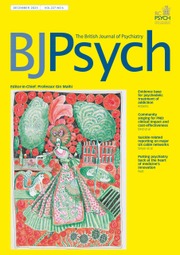We think in the form of either words or mental imagery. We know less about the latter. Mental imagery is like weak perception (without the percept), recruiting similar neural circuitry. Imagining daffodils, as Wordsworth wrote, ‘that flash upon that inward eye’ brings solace. Negative events flashing into mind, like intrusive memories of trauma, bring overwhelming emotions. Allowing time travel, imagery can ‘flashforward’ to suicide. By amplifying emotion and behaviour, imagery drives psychopathology across mental disorders. Directly asking patients about mental imagery benefits assessment. Being curious about mental imagery enriches the science of mental life and may also open doors clinically.
Crossref Citations
This article has been cited by the following publications. This list is generated based on data provided by Crossref.
Hoppe, Johanna M.
Holmes, Emily A.
and
Agren, Thomas
2022.
Imaginal extinction and the vividness of mental imagery: Exploring the reduction of fear within the mind’s eye.
Behavioural Brain Research,
Vol. 418,
Issue. ,
p.
113632.
Hales, Susie A.
Young, Kerry
Iyadurai, Lalitha
Blackwell, Simon E.
Kanstrup, Marie
and
Holmes, Emily A.
2022.
Comprehensive Clinical Psychology.
p.
228.
Agren, Thomas
Hoppe, Johanna M.
Singh, Laura
Holmes, Emily A.
and
Rosén, Jörgen
2023.
The neural basis of Tetris gameplay: implicating the role of visuospatial processing.
Current Psychology,
Vol. 42,
Issue. 10,
p.
8156.
Agren, Thomas
and
Dritschel, Barbara
2023.
Physiological and subjective arousal to prospective mental imagery: A mechanism for behavioral change?.
PLOS ONE,
Vol. 18,
Issue. 12,
p.
e0294629.
Agren, Thomas
and
Hoppe, Johanna M.
2024.
Extensive functional connectivity between brain areas implicated in mental imagery production and phobic fear during both emotional and neutral mental imagery.
Behavioural Brain Research,
Vol. 462,
Issue. ,
p.
114893.
Lam, Charlene L.M.
Hin, Andy S.
Lau, Luciana N.S.
Zhang, Zhiqi
and
Leung, Chantel J.
2025.
Mental imagery abilities in different modalities moderate the efficacy of cognitive bias modification for interpretation bias in social anxiety.
Journal of Behavior Therapy and Experimental Psychiatry,
Vol. 88,
Issue. ,
p.
102031.


eLetters
No eLetters have been published for this article.